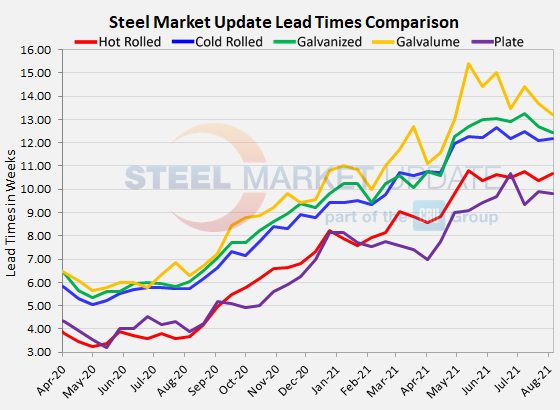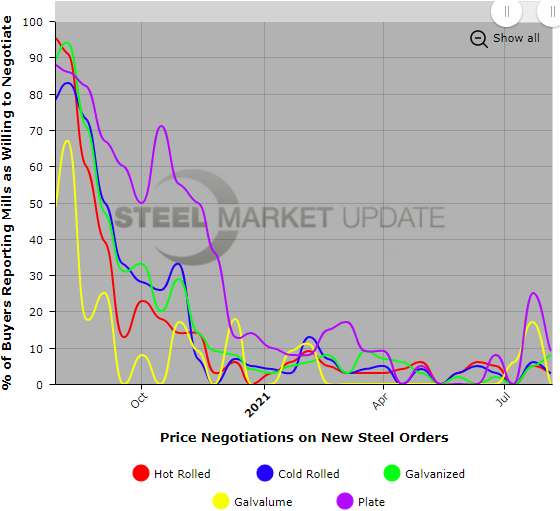SMU Data and Models

Mill Lead Times/Negotiations: No Significant Change
Written by Tim Triplett
August 5, 2021
Steel Market Update’s check of the market this week shows no significant change in lead times for deliveries of spot orders from the mills. Average lead times for hot rolled orders remain above 10 weeks, while those for cold rolled and coated products are still above 12 weeks – at least twice as long as normal. SMU is keeping a close eye out for any shortening of lead times, which would signal a change in market conditions that could presage lower steel prices. There are no signs of that yet.
Lead times for hot rolled now average 10.67 weeks, up slightly from 10.36 weeks in the last survey. Cold rolled lead times inched up to 12.17 weeks from 12.11 two weeks ago. At 12.45 weeks, lead times for galvanized products are down slightly from 12.68 weeks earlier this month. Lead times for spot orders of Galvalume have dipped to 13.22 weeks from 13.67. Average plate lead times also saw a small downtick to 9.83 weeks, from 9.90.
Based on three-month moving averages, which smooth out the weekly volatility, flat-rolled lead times remain near historic highs. The 3MMA for hot rolled lead times now averages 10.54 weeks, cold rolled 12.30 weeks, galvanized 12.89 weeks, and Galvalume 14.03 weeks. Plate’s 3MMA has risen to 9.81 weeks.
None of the changes in the most recent data represent more than a day or two difference, up or down. Only when lead times see downswings of a week or more – indicating that the mills are less busy – should prices be expected to follow.


Negotiations
There’s also nothing new to report on steel price negotiations. Nearly all the respondents to this week’s poll confirmed that the mills still have all the leverage when it comes to price. “Still no negotiations of any kind, and very limited tonnages out there at the mill level,” one service center executive said. Mills may eventually be disappointed in their order levels because so many buyers have committed to cheaper imports, noted another.
By Tim Triplett, Tim@SteelMarketUpdate.com


Tim Triplett
Read more from Tim TriplettLatest in SMU Data and Models

SMU Scrap Survey: Sentiment Indices rise
Both current and future scrap sentiment jumped this month, though survey participants reported responses before key trade news was announced.

SMU Survey: Sentiment splits, buyers have better view of future than the present
SMU’s Steel Buyers’ Sentiment Indices moved in opposite directions this week. After rebounding from a near five-year low in late June, Current Sentiment slipped again. At the same time, Future Sentiment climbed to a four-month high. Both indices continue to show optimism among buyers about their company’s chances for success, but suggest there is less confidence in that optimism than earlier in the year.

SMU scrap market survey results now available
SMU’s ferrous scrap market survey results are now available on our website to all premium members. After logging in at steelmarketupdate.com, visit the pricing and analysis tab and look under the “survey results” section for “ferrous scrap survey” results. Past scrap survey results are also available under that selection. If you need help accessing the survey results […]

SMU flat-rolled market survey results now available
SMU’s latest steel buyers market survey results are now available on our website to all premium members. After logging in at steelmarketupdate.com, visit the pricing and analysis tab and look under the “survey results” section for “latest survey results.” Past survey results are also available under that selection. If you need help accessing the survey results, or if […]

SMU Survey: Sheet lead times stabilize, plate contracts
Mill lead times for sheet products were steady to slightly longer this week compared to our late June market check, while plate lead times contracted, according to steel buyers responding to this week’s market survey.
